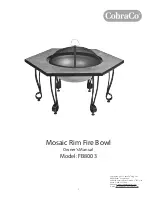
27
ANODE ROD
Each water heater contains at least one anode rod, which will
slowly deplete (due to electrolysis), prolonging the life of the water
heater by protecting the glass-lined tank from corrosion. Adverse
water quality, hotter water temperatures, high hot water usage,
and water softening methods can increase the rate of anode rod
depletion. Once the anode rod is depleted, the tank will start to
corrode, eventually developing a leak.
Certain water conditions will cause a reaction between the anode
rod and the water. The most common complaint associated with
the anode rod is a “rotten egg smell” produced from the presence
of hydrogen sulfi de gas dissolved in the water. IMPORTANT: Do
not remove this rod permanently as it will void any warranties.
The parts list includes a special anode rod that can be ordered if
water odor or discoloration occurs. NOTE: This rod may reduce
but not eliminate water odor problems. The water supply system
may require special fi ltration equipment from a water conditioning
company to successfully eliminate all water odor problems.
Artifi cially softened water is exceedingly corrosive because the
process substitutes sodium ions for magnesium and calcium ions.
The use of a water softener may decrease the life of the water
heater tank.
The anode rod should be removed from the water heater tank
every 3 years for inspection. NOTE: Artifi cially softened water
requires the anode rod to be inspected annually.
The following are typical (but not all) signs of a depleted anode rod:
• The majority of the rod's diameter is less than 3/8" (9.5 mm).
• Signifi cant sections of the support wire (approx. 1/3 or more of
the anode rod's length) are visible.
ANODE ROD DEPLETION
FIGURE 32B.
If the anode rod shows signs of either or both, it should be replaced.
NOTE: Whether re-installing or replacing the anode rod, check for
any leaks and immediately correct if found. In situations where
clearance above the water heater is limited, it may be necessary to
bend the anode rod for removal. Flexible anode rods are available
for replacement.
In replacing the anode:
1. Turn off gas supply to the water heater.
2. Shut off the water supply and open a nearby hot water faucet to
depressurize the water tank.
3. Drain approximately 5 gallons (18.9 L) of water from the
tank (Refer to the "Draining and Flushing" section for proper
procedures). Close drain valve.
4. Remove old anode rod.
5. Use Tefl on
®
tape or approved pipe sealant on threads and install
new anode rod.
6. Turn on water supply and open nearby hot water faucet to purge
air from water system. Check for any leaks and immediately
correct any if found.
7. Restart the water heater as directed under the "Operating Your
Water Heater" section. See the "Repair Parts Illustration" section
for anode rod location.
TEMPERATURE-PRESSURE
RELIEF VALVE OPERATION
The temperature-pressure relief valve must be manually operated
at least once a year.
FIGURE 33.
When checking the temperature-pressure relief valve operation,
make sure that (1) no one is in front of or around the outlet of the
temperature-pressure relief valve discharge line, and (2) that the
water discharge will not cause any property damage, as the water
may be extremely hot, see Figure 33.
If after manually operating the valve, it fails to completely reset and
continues to release water, immediately close the cold water inlet
to the water heater, follow the draining instructions, and replace the
temperature-pressure relief valve with a new one.
If the temperature-pressure relief valve on the appliance weeps
or discharges periodically, this may be due to thermal expansion.
Содержание POWER DIRECT VENTED GAS MODELS
Страница 3: ...3 ...
Страница 23: ...23 ...
Страница 34: ...34 NOTES ...
Страница 35: ...35 NOTES ...










































